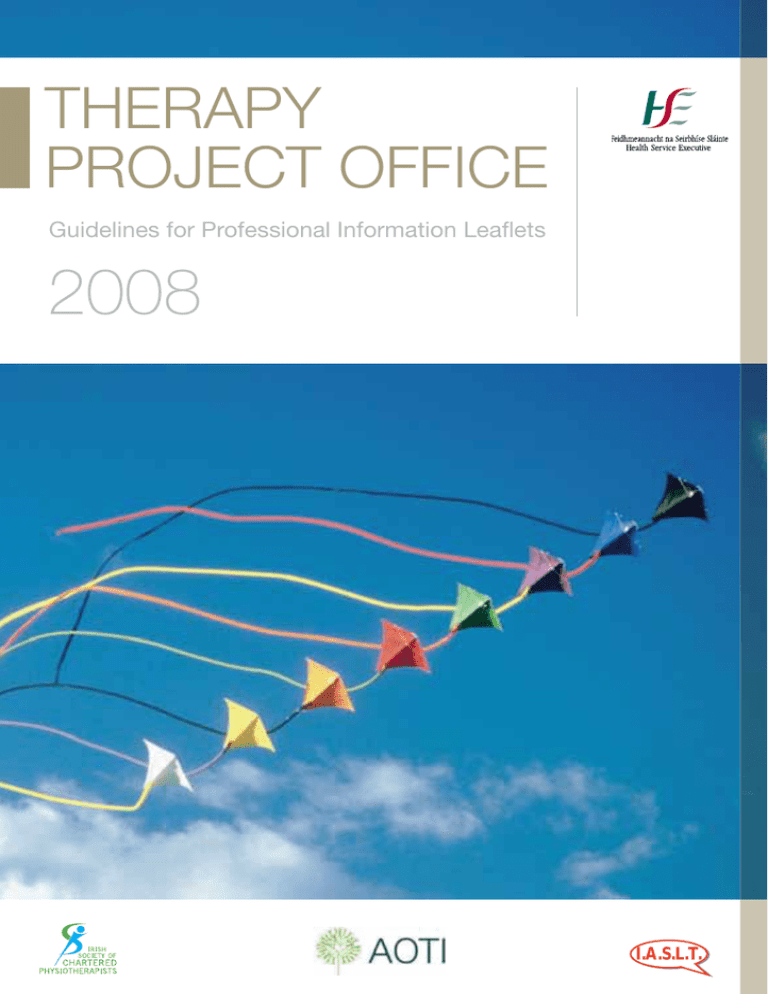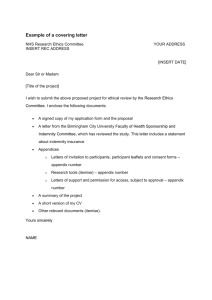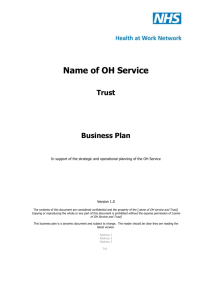2008 THERAPY PROJECT OFFICE Guidelines for Professional Information Leafl ets
advertisement

THERAPY PROJECT OFFICE Guidelines for Professional Information Leaflets 2008 I.A.S.L.T. Guidelines for Professional Information Leaflets Therapy Project Office 3 Contents Contents 4 Therapy Project Office 5 Introduction 6 Responsibilities 9 Producing the Leaflet 11 Make your information easy to understand 14 References 15 Appendix 1 Working Group Members Acknowledgements 16 15 Appendix 2 Sample Consent Form 17 16 Appendix 3 Plain English Checklist 19 15 17 Appendix 4 Useful Irish Support Services 19 4 Guidelines for Professional Information Leaflets Therapy Project Office Therapy Project Office Therapy Project Office The Therapy Project Office was established in January 2007 to progress and initiate project activities on behalf of the National Implementation Group (NIG) for Clinical Placement Provision for Occupational Therapy, Physiotherapy and Speech & Language Therapy. The projects related to a number of key actions identified by the ‘The Report of the National Planning Group on Clinical Placement Provision for Occupational Therapy, Physiotherapy and Speech and Language Therapy’ (2004), under the three broad areas of: Practice Education Continuing Professional Development Quality Information for the Public The Therapy Project Office was funded by the HSE and staffed by three project managers, representing the professional bodies of the Association of Occupational Therapists of Ireland (AOTI), the Irish Society of Chartered Physiotherapists (ISCP) and the Irish Association of Speech & Language Therapists (IASLT). A collaborative, project management model was applied throughout the process. The Project Managers also worked in partnership with the Higher Education Institutes, Therapy Services, the Department of Health & Children and the Health Service Executive to build on existing work and to drive the projects forward. Guidelines for Professional Information Leaflets Therapy Project Office 5 These guidelines have been developed as part of a multi-disciplinary project co-ordinated by the Therapy Project Office in collaboration with representatives from the three professions of Speech and Language Therapy, Occupational Therapy and Physiotherapy. They represent a uniform set of guidelines for the three professions. It is acknowledged that at this point in time, each of the three Bodies will have differing infrastructures to support the development of these good practice guidelines and therefore, each Professional Body will implement them in accordance with its own needs and resources. The purpose of these guidelines is to: Facilitate the professions in the development of quality, accessible public information leaflets in a standardised format. Positively promote the public image of the professions through consistency in the quality of leaflet information. Outline the responsibilities of the expert advisory/clinical interest groups within the Professional Bodies when producing leaflets. Provide a useful reference for members to apply in their work practice. The appendices and references at the end of this document contain useful resources and guidelines for promoting accessibility. Introduction Introduction 6 Guidelines for Professional Information Leaflets Therapy Project Office Responsibilities Responsibilities Responsibilities of the Professional Body Each Professional Body will be responsible for guiding members and/or groups in the development of information leaflets. The guidelines for professional information leaflets should be reviewed after a two year period. A database of information leaflets produced by the expert advisory/clinical interest groups will be maintained by the Professional Body via the Professional Body website. All leaflets should be reviewed one year from date of publication. The person or the committee responsible for reviewing leaflets will vary for each Professional Body. In the Irish Society of Chartered Physiotherapists (ISCP), the Communications & Events Co-ordinator will contact Clinical Interest Groups (CIGS) and branches one year from date of publication for review of leaflets. Responsibilities of Groups or Individual Members It is the responsibility of the group producing the leaflet to adhere to the guidelines. When a leaflet is being produced by an advisory/clinical interest group, the chairperson of the group should take the responsibility of ensuring that the information in the leaflet is current and represents professional best practice. When getting leaflets professionally printed ensure that the printing company also comply with these guidelines. Leaflets should aim to use plain language and clear layouts to help the reader access information easily. Information on ‘Plain English’ guidelines and support service offered by the National Adult Literacy Agency (NALA) are available in appendices two and three. Members or groups producing leaflets should familiarise themselves with NALA’S support services. Therapy Project Office It is important to test out any leaflet with the people who are likely to be reading it to ensure that you are getting your message across effectively. For target audiences who do not have English as their first language, it is advised that a professional interpreter service should be contracted for translations. Leaflets can be produced in hard copies and/or in electronic format available on websites. Reasonable requests for leaflets to be made in alternate formats should be met, where possible. Logo The Professional Body logo can only be used on leaflets that have been endorsed by the Professional Body. On approval of the leaflet, the logo is supplied by the professional body in PDF format. It is not permitted to change the size or position of any elements within the logo. It is not permitted to change the colours within the logo. Each Professional Body will have its own procedures for sanctioning the use of its logo and its own particular logo guidelines. When using the Professional Body Logo on Leaflets, the logo should appear on the same place on the front and back pages of each leaflet as laid out in the template designs. If the leaflet was produced in collaboration with another agency, such as Health Promotion Unit, place the other party’s logo at the back of the leaflet alongside your own Professional Body’s logo. 7 Responsibilities Guidelines for Professional Information Leaflets 8 Guidelines for Professional Information Leaflets Responsibilities Using Pictures or Graphics Therapy Project Office Consent When including pictures of people in a leaflet, you need to seek written permission to do so from the individuals concerned. A sample consent form is included in appendix one. Internet Remember that you need to seek permission to download and reproduce images and photographs from the internet. This includes cartoons. Printing Company It is useful to know that some printers have ownership over a stock of photographs and images and these could be used in leaflet production. Quality The photographic quality of digitally produced photographs needs to be greater or equal to 10 mega pixels. Photo Bank It is recommended that each professional body would build up a bank of its own photographs and images, which can be reproduced in approved leaflets. Use of Clip Art or graphics Tips for presenting graphics, such as clip art are included further on in the document. Guidelines for Professional Information Leaflets Therapy Project Office 9 Document Layout Leaflet templates are available in the members section of the professional body’s website. Arrange your content within a selected template. Always use a consistent layout for each content section. Make use of white space and headings to provide relief from the text. Cover Design The title and cover design should tell readers what the leaflet is about. The cover design is laid out in a standardised format to promote a consistent and recognizable image for the professions. Subject Heading – what the leaflet is about Picture/Graphic Logo (Left hand Corner) Professional Body’s Title, e.g. Physiotherapy Producing the Leaflet Producing the Leaflet 10 Guidelines for Professional Information Leaflets Producing the Leaflet List of Contents Therapy Project Office For longer documents such as booklets, include a list of contents as a useful navigational aid. Contact Details Contact details should be placed on the back of each leaflet. Paper Type Use matt paper rather than glossy paper Minimum paper weight should be 80gsm. It would be preferable to use a paper that weighs at least 90gsm- a little thicker than ordinary photocopying paper. Font Size: 12-point type size is the minimum size that should be used. To promote access for people with low vision, use 14 point for the main text, 16 font size for headings and 18 font size for titles. Use an easy to read font such as Arial or Times New Roman. Avoid decorative letters. Headings: In general increase your headings by 2 points from the size of the main font Make headings Bold Be consistent in the positioning of headings Only use centred text for main headings or titles Subheadings – give a message rather than simply name the section Guidelines for Professional Information Leaflets Therapy Project Office 11 Use of Language Sentences should contain no more than 20 words. Avoid using complicated words or jargon if more everyday words and phrases would do. Using plain language saves time and avoids misunderstanding as people can understand information first time. If you must use specialised terms, define them. Not every reader will be as familiar as you are with the terms you use every day in your practice. Be personal Use pronouns such as ‘we’ and ‘you’ instead of terms such as ‘the organisation’ and ‘the client’. Use active rather than passive verbs, for example: ‘The dog fetched the ball’ (Active) ‘The ball was fetched by the dog’ (Passive) Paragraphs Align text to the left, as this makes it easier for the reader to find the beginning of each line. Aim to limit each paragraph to one idea and keep each as short as possible. Leave at least one full line between paragraphs. This will divide the text into sections, making it easier to navigate. Try not to have a paragraph start on one page and end on the next – either make it more concise or start it on the next page. Consider bullet points or lists to break up long or complicated paragraphs. When using bullet points, make sure they are solid Make your Information Easy to Understand Make your Information Easy to Understand Guidelines for Professional Information Leaflets Make your Information Easy to Understand Therapy Project Office 12 ‘Dos & Don’ts’ when presenting information Do highlight important information using a large font size, bold type or a contrasting colour text. Don’t underline words or put them in italics as these make it more difficult to recognise their shape. People pick out the shape of a word rather than every single letter when they read. Do try to avoid using too many abbreviations (for example Building regs), initials (for example, NCBI) or acronyms (for example FETAC). If you must use them, always spell them out in full and put in brackets right afterwards Do not use vertical or curving text Do Write out the word ‘three’ or ‘eight’ or choose a font that has clear numerals. The numbers 3, 5 and 8 and, also with some fonts, 0 and 6 can be difficult to recognise. Don’t write a full word in CAPITAL LETTERS. Do use colour contrast effectively – this is crucial for people with low vision and literacy difficulties. Black text on white paper can sometimes give too much reflection and glare, so use a muted colour paper with contrasting colour text, for example navy text on cream paper. Clip Art or Graphics Use graphics to convey messages rather than decorate the material. Use realistic drawings and photographs that your audience can identify with. Use images and photos with clear edges and good colour contrast. Therapy Project Office Avoid images or photographs with too much detail. Do not place text over an image, as this will make the text more difficult to read. For example: Do not place text over an image, as this will make the text more difficult to read. Do not wrap text around an image, as it means that each line starts in a different place. Do not place an image between as it will distract the reader. columns of text, Use a Questions & Answers Format A questions and answers format can be very user friendly for readers. They don’t have to read the whole document but can go straight to the area which particularly interests them. 13 Make your Information Easy to Understand Guidelines for Professional Information Leaflets 14 Guidelines for Professional Information Leaflets Therapy Project Office References References ‘Code of Practice on Accessibility of Public Services and Information Provided by Public Bodies’, National Disability Authority (NDA). www.nda.ie Guidelines on the Development of Information Leaflets within the Adelaide and Meath Hospital, Dublin Incorporation the National Children’s Hospital, September 2005. HSE Guidelines for Accessible Publications: ‘How to write clearly and be understood’. National Council for the Blind in Ireland (NCBI), ‘Make it Clear’. This is a very useful checklist to ensure that documentation is accessible for people with low vision or visual impairment. Download the documents at www.ncbi.ie/files/make_it_clear_ncbi.doc Writing & Design Tips, National Adult Literacy Agency (NALA). This document is free on request and can also be downloaded free from NALA’s site. Guidelines for Professional Information Leaflets Therapy Project Office 15 Working Group Members Helen Ni Mhurchú, Publications Committee for UPDATE, Irish Society of Speech & Language Therapists (IASLT) Lisa Stafford, Communications & Events Co-ordinator, Irish Society of Chartered Physiotherapists (ISCP) Michelle Cotter, Public Relations & Members Affairs Committee. Association of Occupational Therapist in Ireland (AOTI) Acknowledgements The working group wish to thank and to acknowledge the help and support that was received in producing this document from the following organisations: The Adelaide Meath and National Children’s Hospital (AMNCH) for supplying us with a copy of the hospital’s guidelines for leaflets. The Communications Department, Health Services Executive (HSE) for providing us with the organisation’s guidelines for producing accessible documentation. National Adult Literacy Agency (NALA) for letting us reproduce its ‘checklist for NALA Plain English Mark’, which is included in appendix 3. National Council for the Blind in Ireland (NCBI) who have given permission to reproduce a weblink for its ‘Make it Clear’ document, which gives guidelines on producing written information which is accessible to everyone. You can find this weblink in appendix 3. Appendix 1 Appendix 1 16 Guidelines for Professional Information Leaflets Therapy Project Office Appendix 2 Appendix 2 Sample Consent Form Irish Professional Body’s Name & Logo Address of Professional Body Consent for use of images I, ___________________, hereby give consent for the use of public images of me to be displayed on the Irish Professional Body’s website and on publications, such as leaflets, posters, etc. Signed: __________________ Date: ___________________ Name of witness (please print): _______________________ Signed by the above named witness: __________________ Date: ___________________ Guidelines for Professional Information Leaflets Therapy Project Office 17 Plain English checklist Checklist for NALA Plain English Mark Twenty Yes No questions on your document This checklist offers a quick way for you to review a document, such as a letter, report or information leaflet, to see whether it is in plain English. Some questions may not apply, but aim to answer ‘yes’ to as many of the others as possible. Language, punctuation and grammar 1. Does it use ‘you’ and ‘we’? 2. Does it use the active voice most of the time? 3. Does it keep jargon to a minimum? 4. Does it explain any specialised terms in clear language? 5. Does it define acronyms and other abbreviations? 6. Does it use terms in a consistent way? 7. Does it cut out unnecessary words and details? 8. Does it have an average of 15 to 20 words in each sentence? 9. Does it use correct punctuation? 10. Does it use the simplest verb tense possible? 11. Does it avoid nominalizations (nouns made normally from verbs)? 12. Does it avoid Latin and French phrases and Latin abbreviations? Appendix 3 Appendix 3 18 Guidelines for Professional Information Leaflets Appendix 3 Structure Therapy Project Office 13. Does it keep paragraphs reasonably short? 14. Does it use informative headings or questions to break up long text? 15. Does it use bullet point lists for detailed or complicated information? 16. Does it organise information according to the reader’s needs? 17. Does it include a natural flow from one point to the next? Page design 18. Does it use a readable typeface (font and size)? 19. Does it avoid underlining, groups of capital letters and italicized phrases? 20. Does it align paragraphs to the left and use at least 1.5 spacing? © National Adult Literacy Agency, 2005 This checklist may be reproduced only with permission and relevant credits. For more information, contact NALA at literacy@nala.ie or on (01) 855 4332. Guidelines for Professional Information Leaflets Therapy Project Office 19 Useful Irish Support Services 1. www.nala.ie NALA Plain English Service offers the following supports: Editing documents, leaflets or posters. Offering advice on plain English Facilitating training and workshops in plain English for groups and organisations. 2. www.NCBI.ie NCBI offers a range of services to public and private organisations to make sure their services are accessible to people who are blind and vision impaired. They will also offer advice for producing accessible written information in addition to its downloadable ‘Make It Clear’ document. Appendix 4 Appendix 4 Authors Aine Clyne ___________________ Project Manager, AOTI Charlotte McCoubrey ________ Project Manager, IASLT Vanessa Hamilton_____________ Project Manager, ISCP I.A.S.L.T. ASSOCIATION OF OCCUPATIONAL THERAPISTS OF IRELAND Irish Association of Speech and Language Therapists

